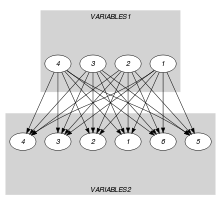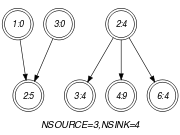5.77. common_modulo
| DESCRIPTION | LINKS | GRAPH |
- Origin
- Constraint
- Arguments
- Restrictions
- Purpose
is the number of variables of the collection of variables taking a value situated in an equivalence class (congruence modulo a fixed number ) derived from the values assigned to the variables of and from .
is the number of variables of the collection of variables taking a value situated in an equivalence class (congruence modulo a fixed number ) derived from the values assigned to the variables of and from .
- Example
-
In the example, the last argument defines the equivalence classes , , , , and where is an integer. As a consequence the items of collection respectively correspond to the equivalence classes , , , and . Similarly the items of collection respectively correspond to the equivalence classes , , , , , and . The constraint holds since:
Its first argument is the number of equivalence classes associated with the items of collection that also correspond to equivalence classes associated with .
Its second argument is the number of equivalence classes associated with the items of collection that also correspond to equivalence classes associated with .
- Typical
- Symmetries
Arguments are permutable w.r.t. permutation .
Items of are permutable.
Items of are permutable.
An occurrence of a value of can be replaced by any other value such that is congruent to modulo .
An occurrence of a value of can be replaced by any other value such that is congruent to modulo .
- Arg. properties
Functional dependency: determined by , and .
Functional dependency: determined by , and .
- See also
specialisation: ( replaced by ).
- Keywords
characteristic of a constraint: modulo.
constraint arguments: constraint between two collections of variables, pure functional dependency.
- Arc input(s)
- Arc generator
-
- Arc arity
- Arc constraint(s)
- Graph property(ies)
-
- Graph class
-
- Graph model
Parts (A) and (B) of Figure 5.77.1 respectively show the initial and final graph associated with the Example slot. Since we use the and graph properties, the source and sink vertices of the final graph are stressed with a double circle. Since the graph has only 3 sources and 4 sinks the variables and are respectively equal to 3 and 4. Note that the vertices corresponding to the variables that take values 8, 7 or 2 were removed from the final graph since there is no arc for which the associated arc constraint holds.
Figure 5.77.1. Initial and final graph of the constraint


(a) (b)